For beginners, understanding the water requirements of plants is an essential factor. Too much water without proper drainage can seriously harm plants’ health. In potted plants, drainage is necessary because the roots of the plants are very sensitive to excess moisture. However, considering the material of pots, draining holes, potting mixes, and suitable soil all become overwhelming for a beginner. Therefore, this article will answer your most frequently asked question: What can I use to improve the drainage in potted plants?
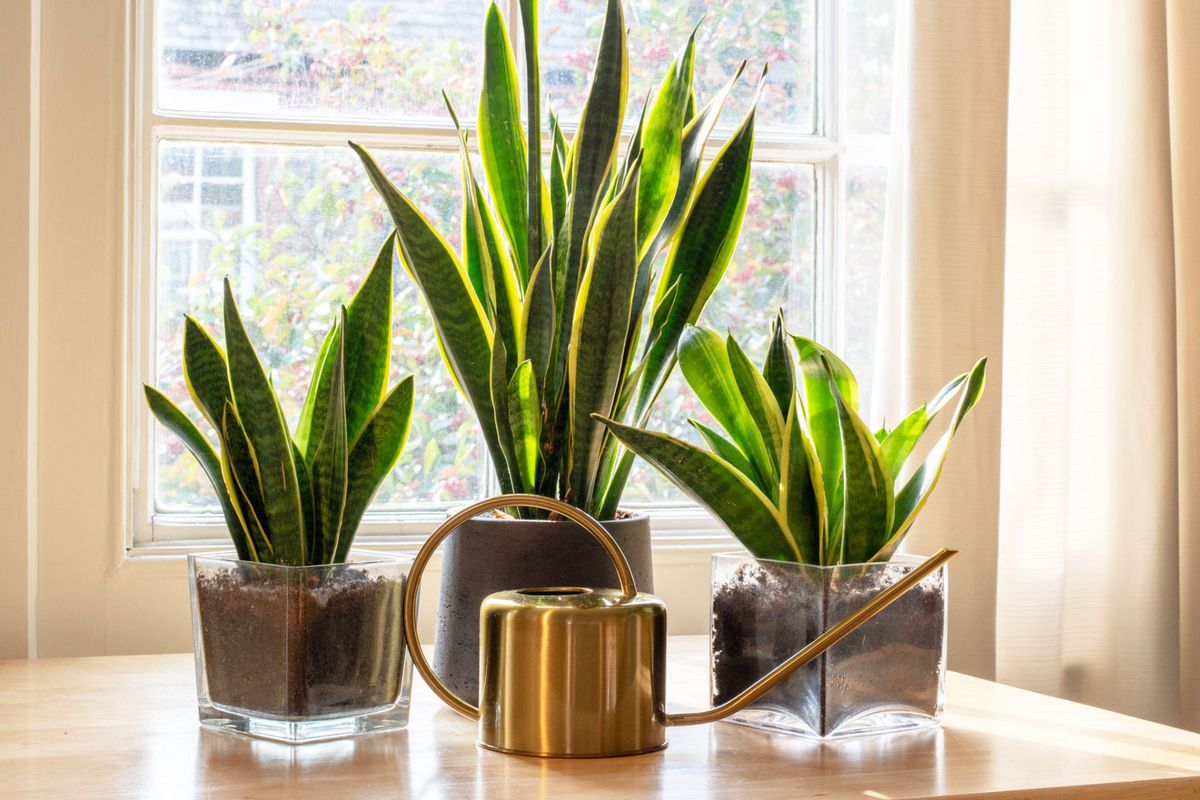
Why is improve the drainage in potted plants important?
Pot drainage is the most critical factor affecting a plant’s health. Because without proper drainage, the access water in the pot is not suitable for the roots of the plant. Therefore, adequate drainage holes are important to have in a pot.

When we plant directly in the soil in the garden, there are various ways for the water to seep into the earth, so over watering is not a problem in this case. However, for potted plants, over-watering without proper drainage can result in severe consequences. The leaves start to turn yellow and droopy, and then the roots become black, causing the death of the plants.
The overwatering becomes fatal when the drainage holes are: 1) not present in the pot, 2) the drainage holes are blocked with soil, and 3) the soil mix used for potting plants does not have fast-draining abilities. Thus the water can easily retain in the soil, and excess water does not run out of saturated soil. If you detect the problem at the start, then you can take immediate steps, and recover the plant. However, once the root rot occurs, there is no revival for the plant.
Root Rot
If the excess water remains in the pot, then the soil remains wet most of the time. Moreover, if you keep on watering the plant. It results in plant roots not getting enough oxygen, resulting in the roots’ blackening. Root rot is the biggest threat to the plant as it can cause the plant’s death if not treated promptly. However, if you can identify the root rot, treatments can be done, and there are chances for the plant’s survival.
How to identify root rot?
Since roots are covered deeply in the soil, there is no way you can check the roots without taking the plant out of the soil. However, there are some symptoms that the plant shows when its roots are affected by overwatering. However, plants show the same symptoms due to nutrient deficiency, less sun exposure, etc. So, it becomes challenging to identify the root rot. But you can always keep a check on the condition of the plant and can take steps accordingly.
- Unable to grow: If you are tending to the plant properly. You give it water on time, adding the fertilizers according to need. But you notice that the plant is not growing, and the growth is stunted. Then it’s a warning that it can be due to root rot.
- Bad smell: If you observe that a bad smell is coming out of the soil, then this is an indication of root rot.
- Blackened roots: The roots are plump and firm for a healthy plant. However, the roots will turn brown and mushy in an affected plant.
Can I use rocky material in the pot for drainage?
Many plant lovers and gardeners suggest placing a rocky material at the bottom of the pot to improve the drainage of potted plants. Due to this, drainage materials like rocks, gravel, or pebbles are placed over the drainage holes. But is this a good idea? The answer is simply NO.
Rocks or gravels at the base is actually bad for drainage as they hinder the water movement. These materials block the entire drainage hole making it difficult for water to move through the pot.
Puyallup Research and Extension Center of Washington State University
These materials are used widely for draining purposes, but it is not much beneficial for a pot. Since the indoor pots are usually smaller in size, if a 1-inch layer of gravel is placed, the roots get low room to grow. Moreover, blockage of draining holes leads to root rot that can ultimately kill the plant.
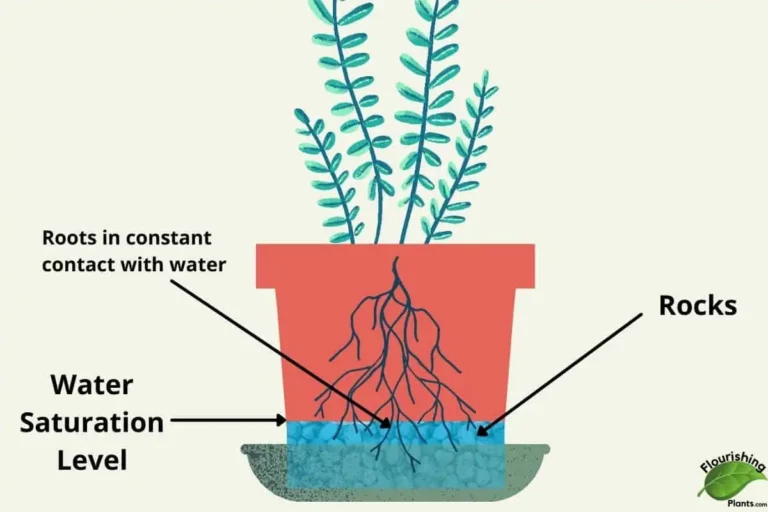
How to improve drainage in potted plants?
The most efficient way to increase drainage in a pot is by adding a well-draining soil mix. By changing the composition of the soil with adequate draining holes in the pot, your plant will be all set to grow
Importance of combination soil mix:
Usually, people use garden soil for potted plants. If a plant is growing well in the garden, that soil will not necessarily make an effective medium for the potted plants. In the garden bed, the excess water has different ways of leaving the soil. Therefore well-aerated soil is not a requirement. However, when a plant is confined in a pot, it needs proper drainage to hold enough water for the plant’s growth and get rid of excess water.
A good potting soil should have the capacity to retain some air and moisture and yet drain well and hold nutrients.
The best medium consists of a combination of small and large particles. If the potting medium has very small particles like clay, there will be no room for air. Hence, the water will take longer to drain. Similarly, if the soil has very large particles like sand, the water will drain quickly, and the roots will not get enough water. So you can use soil amendments by adding various materials to make a well-aerated and well-drained soil mix for the potted plants.
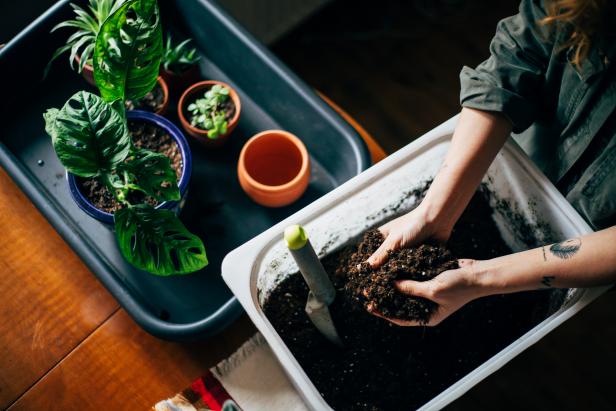
Using soil amendments to improve drainage in potted plants
You can add soil amendments to the soil to improve the water drainage. These materials help increase the airspaces between particles, providing circulation space and proper drainage to the soil. We have made a list of some soil amendments material that you can mix with the soil for improving the drainage of the soil.
- Perlite

Perlite is another popular material that you can use to improve the drainage in potted plants. After rapid heating, we can get this volcanic silicate rock. Therefore, perlite is very light in weight. Moreover, it does not decompose easily as it is made of highly heated volcanic rocks. It has an excellent ability to increase drainage and soil aeration as it can increase airspace in the soil. Since it is non-absorbent, it does not retain water and helps in fast drainage.
Gardener’s tip: To increase efficiency, use bigger particles for larger pots and fine particles for smaller pots
However, there are some challenges you have to face while using perlite in your soil. Due to its lightweight, it can float in water and does not mix well with soil. Also, it can be easily blown by the wind. Moreover, for heavier plants, perlite becomes less efficient.
- Pumice:
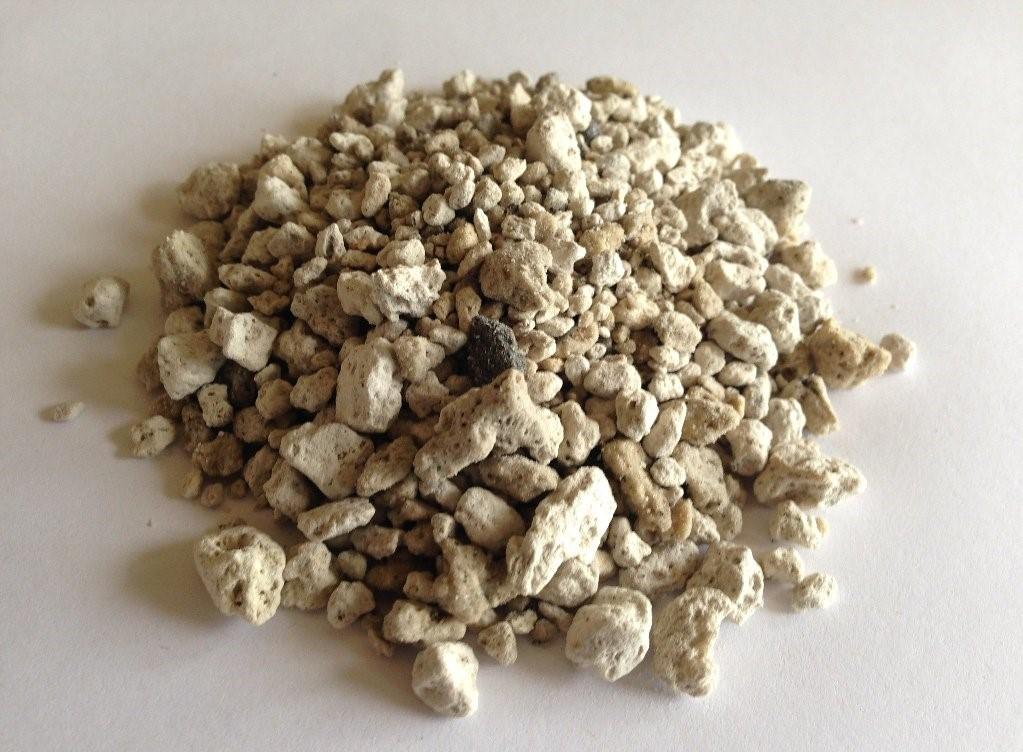
The next soil amendment is pumice, which is very is a good option that we can add in soil to improve drainage in potted plants. Pumice is lightweight but heavier than perlite and stays mixed in the soil. It is highly porous. Furthermore, it does not compact or decompose over time quickly. With its excellent aeration and water draining abilities, it improves the overall health of plants. For soils having more sand content, go with pumice as it drains excess moisture and prevents root rot.
Gardener tip: For soils having more sand content, pumice is always the better option.
However, it can not retain water, unlike other soil amendments. Moreover, it is not readily available in all parts of the world. So, it is not easy to get, that is why its price is very high. Pumice is an excellent option for plants, but its main drawback is its cost.
- Vermiculite
With vermiculite, the potting soil can easily retain water and nutrients and does not flush down with the water through drainage holes. It is very flaky and porous, creating air pockets in the soil for good aeration. Since it retains moisture and provides aeration to densely packed soil, it does not allow the excess water to suffocate the roots. Moreover, it supplies nutrients to the plant over time.
It is non-toxic and environmental friendly. Vermiculite is enriched in nutrients like potassium, magnesium, and calcium, which benefit plant growth. It is highly absorbent and can retain water and nutrients.
The pH of this material is alkaline, so it is not suitable for all kinds of plants. However, it has an excellent buffering capacity and can maintain a stable pH in the soil. Furthermore, it can be compressed easily, and if pressed when soil is wet, it loses its structure.
- Coarse sand

Another amendment is coarse sand which is excellent for waterlogged soil. The sand particles provide aeration by creating air spaces in the soil. So the water can easily flow through the soil. Moreover, it helps the soil to drain quickly.
However, it is unable to retain water. Therefore, the nutrients also wash away quickly with water. Moreover, the sand makes the pot very heavy. You may need assistance in moving the pot that has sandy contents.
- Peat Moss

if you want to improve the drainage in potted plants, then peat moss is another option. This fibrous amendment can improve soil quality. It has water retention and aeration abilities. Therefore, it can help the oxygen reach the roots properly, keeping them well aerated. Moreover, clay soil helps in improving drainage. In contrast, soil that has more sand content helps in retaining water. However, it has no nutrient properties but can provide retained nutrients and moisture.
However, experts generally do not recommend Peat moss because it is not suitable for the environment as it has a non-renewable resource. The mining process releases carbon dioxide, which contributes to the greenhouse gases that cause global warming. And it is not readily available, so it is relatively expensive.
- Coconut Coir

Coconut coir is a natural and sustainable product. It improves the drainage in potted plants. Also, it increases moisture retention in fast-draining soils. Since the coir has a high absorption ability, it can retain water for a more extended period. Moreover, it creates air pockets allowing the excess moisture to drain from the soil.
The coconut coir can manage moisture in both heavy clay soils and dry sand soils due to its dual drainage and retention properties. It can lighten the clay soil by draining water quickly and retaining moisture for extended periods in sand soil. Since it is more economical than peat moss, it is a perfect replacement for peat moss which is very expensive.
However, using coconut coir has some disadvantages, like it is very porous. Therefore, it cannot support the weight of the plant alone. Moreover, it does not have any nutritional value, and you have to add fertilizer to the plant. Another drawback is its high salt content, which can affect the roots causing root rot.
Conclusion
This article has covered important points on how to improve the drainage in potted plants. If you like this article, visit our website for more articles.
FAQs
Can I use pots without drainage holes?
Decorative pots usually do not have drainage holes. However, if you want to use such pots, you will have to micromanage the water content going it the pot. It is recommended to make holes in the pot by drilling.
How many drainage holes are enough?
It is dependent on the material of your pot. For terracotta and ceramic pots, a single hole is sufficient, but for plastic pots, there should be 4-5 holes for proper drainage of water.
Is perlite suitable for succulents?
Perlite has excellent draining and aeration abilities. So it can be the perfect soil amendment for succulents. A soil mix of potting soil, coarse sand, and perlite in equal quantities will do the needed job.
Can I grow my plants in just soil amendments?
We can some plants successfully in materials like coco peat, perlite, etc. However, they will need continuous monitoring for water retention. And for providing nutrients, fertilizer will be required.

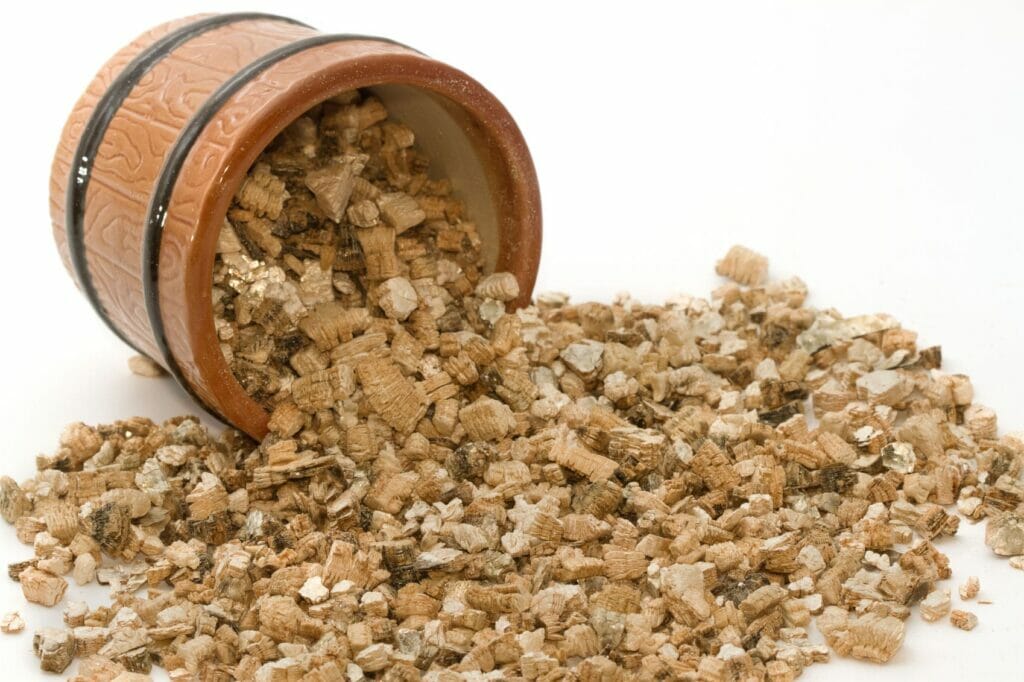
3 Comments
Do You Need Drainage Holes in Pots? - Planter Galleria
June 18, 2022[…] A good solution is adding soil amendments to your regular soil to make a mix that will suit your plant’s needs. A potting mix containing perlite or vermiculite helps improve drainage. You can also make your well-draining soil mix by combining equal parts of sand, peat moss, and perlite. These soil amendments are light in weight and porous, increasing the draining ability of the soil. If you want to know more about soil amendments, read this article https://plantergalleria.com/improve-the-drainage-in-potted-plants/ […]
15 Basic Mistakes That Kill Houseplants - Planter Galleria
June 24, 2022[…] Buying a planter or pot with single or multiple drainage holes can easily prevent poor drainage. Even if you have a beautiful pot with no hole, you can simply drill holes into it. So, you can drain additional water through them. Moreover, you can add soil amendments to the potting mix to make it more draining. Check this article to know more about how you can improve drainage in potted plants https://plantergalleria.com/improve-the-drainage-in-potted-plants/ […]
Must Have Tools for Indoor Plants – A Beginner’s Guide - Planter Galleria
June 30, 2022[…] do not like moist soil and thrive well in fast-draining soil. So for such plants, potting mix with soil amendments like vermiculite, perlite, and pumice is more […]